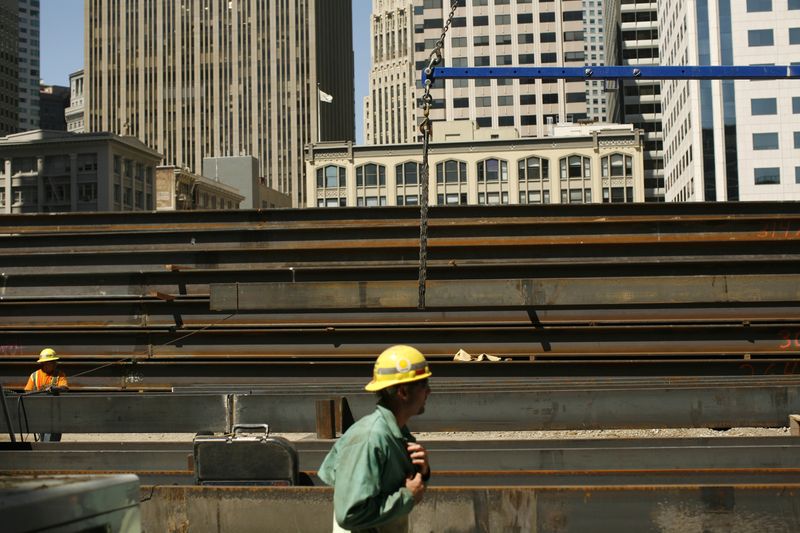By Lucia Mutikani
WASHINGTON (Reuters) - U.S. unit labor costs were much weaker than initially thought in the third quarter amid robust worker productivity, providing a boost to the Federal Reserve's fight against inflation.
The inflation outlook was further brightened by other data on Wednesday showing a moderation in wage growth in November. The reports followed news on Tuesday that job openings dropped to a more than 2-1/2-year low in October.
They strengthened financial market expectations that the U.S. central bank was done tightening monetary policy and could pivot to cutting rates as early as the first quarter of 2024.
"The decline in labor costs points to a further slowdown in services inflation, the last front in the Fed's effort to bring inflation back to 2%," said Nancy Vanden Houten, lead U.S. economist at Oxford Economics in New York. "Our baseline forecast assumes that rate cuts don't start until the third quarter of next year, although the risk may be growing that the Fed starts sooner."
Unit labor costs - the price of labor per single unit of output - fell at a 1.2% annualized rate in the third quarter, the Labor Department's Bureau of Labor Statistics (BLS) said, revised down from the previously reported 0.8% pace of decline. That was the first drop since the fourth quarter of 2022.
Economists polled by Reuters had expected that the decrease in unit labor costs would be revised down to a 0.9% rate.
Growth in unit labor costs was lowered to a 2.6% rate in the second quarter from the previously reported 3.2% pace. Unit labor costs rose at a 1.6% rate from a year ago in the third quarter, the smallest year-on-year increase since the second quarter of 2021.
The moderate growth in annual labor costs bodes well for the Fed's efforts to lower inflation to its 2% target. It is expected to leave interest rates unchanged next Wednesday. The Fed has raised its benchmark overnight interest rate by 525 basis points to the current 5.25%-5.50% range, since March 2022.
Nonfarm productivity, which measures hourly output per worker, increased at a 5.2% rate last quarter. That was the fastest pace since the third quarter of 2020 and was revised up from the previously reported 4.7% rate.
The upgrade was telegraphed last week by revisions to gross domestic product data, which showed the economy growing at a 5.2% rate in the July-September quarter, instead of the previously reported 4.9% pace.
Productivity grew at an unrevised 3.6% pace in the second quarter. It expanded at a 2.4% pace from a year ago in the third quarter, revised up from the previously estimated 2.2% rate.
With economic growth appearing to have significantly slowed down at the start of the fourth quarter, the brisk pace of productivity growth is unlikely to be sustained.
A separate report from the Commerce Department's Census Bureau showed the trade deficit widening 5.1% to $64.3 billion in October as exports declined, suggesting that trade could subtract from GDP growth this quarter.
"There are good reasons to believe this is a pro-cyclical acceleration in productivity growth rather than a catch-up story as productivity is now accelerating above the 2007-2019 trend," said Gregory Daco, chief economist at EY-Parthenon in New York. "Still, we see limited upside for productivity growth as economic activity is expected to downshift."
Stocks on Wall Street were trading higher. The dollar fell against a basket of currencies. U.S. Treasury prices rose.
WAGE GROWTH COOLING
Hourly compensation rose at an unrevised 3.9% pace last quarter, but increased at a downwardly revised 4.0% rate from a year ago. Annual compensation was previously reported to have risen at a 4.2% rate.
Slowing wage pressures were underscored by the ADP National Employment Report, which showed pay increases for workers remaining in their jobs at 5.6% year-on-year in November, the smallest gain since September 2021. Wages for people changing jobs rose 8.3%, the smallest year-on-year increase since June 2021.
The ADP report also showed private payrolls increased by 103,000 jobs last month after rising 106,000 in October.
The ADP report, jointly developed with the Stanford Digital Economy Lab, was published ahead of the release on Friday of the BLS' more comprehensive and closely watched employment report.
The labor market is steadily cooling in the aftermath of the hefty rate hikes. According to a Reuters survey of economists, the employment report is expected to show private payrolls increased by 153,000 jobs in November as about 33,000 striking United Auto Workers union members returned to work.

Private payrolls rose 99,000 in October. Total nonfarm payrolls are estimated to have increased by 180,000 in November after rising 150,000 in the prior month.
"The softer turn of recent labor market releases reduces the risk that inflation pressures revive due to wage-price issues, making it easier for the Fed to pivot to rate cuts in 2024," said Bill Adams, chief economist at Comerica (NYSE:CMA) Bank in Dallas.
